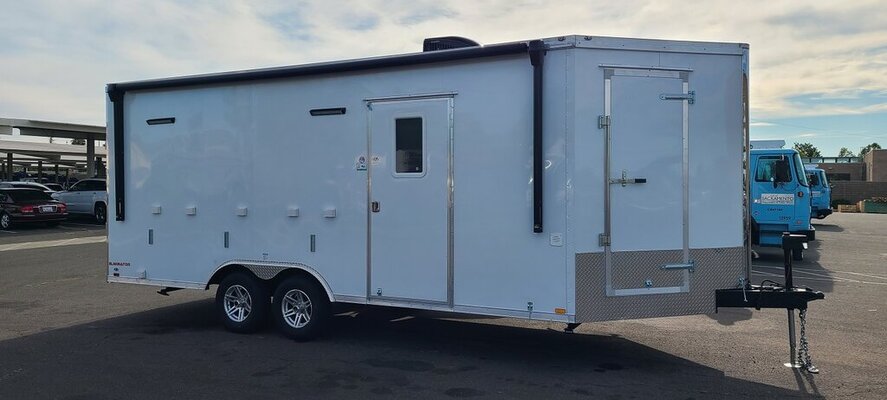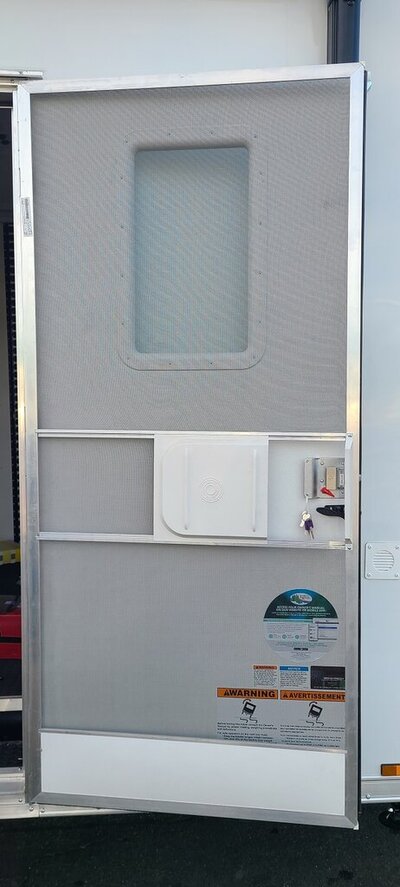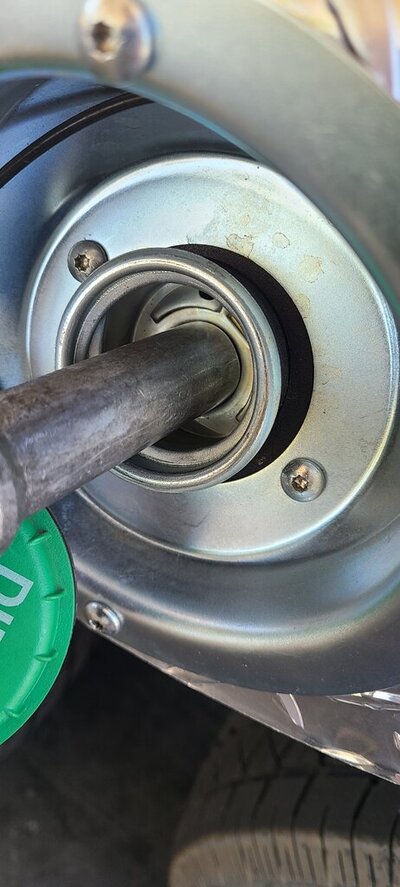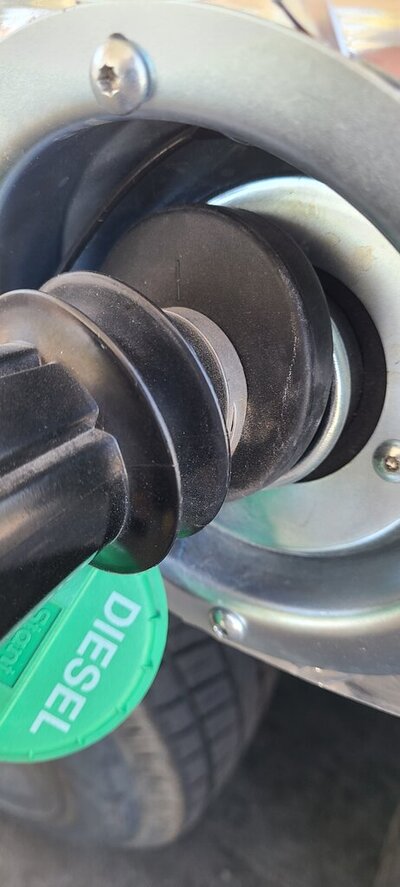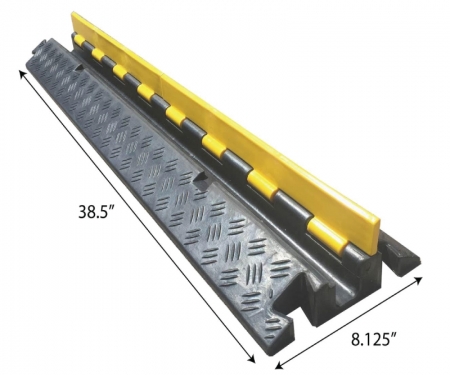Ross956555
New member
I'm with a search and rescue program and we recently received a granted 20' v nose toy hauler with AC, generator, etc. We decided to join the forums to bounce ideas off of you fine folks and to learn the ins-and-outs.
We currently have a fleet of 5 16' dual axle box trailers w/surge brakes...but ACs, on board generators, etc. are new to our fleet.
The trailer...20' CargoMate Eliminator series with a v-nose, 8000w Onan diesel, Dometic 15k A/C unit, Solera 18' electric awning, electric tongue jack, electric brakes. I have more specs if folks need them.
Some questions off of the top of our head and one funny mistake in manufacturing we discovered.
1. The trailer is pretty high up (step-in on the side door is maybe 19" off the ground), and the doorway has a 'step well' - the side door doesn't open directly at floor level. We want to install something like the Lippert steps, but we can't find any information regarding if they will work on a "step well" type of doorway. Has anyone used these before with a 'step well' doorway? Attached pic "0013" you can barely see the step well I'm talking about.
2. Tips for shore power cable protection. We have a 50a connection...but we often deploy on open gravel lots or similar where you'd find a fire base camp. We are trying to figure out if there is any DIY type of solution to help protect our shore power line. We always leave one vehicle space open on any fuel port side of a trailer so the base camp fuel vendor can access us if we need to run on generator power. That means stretching our shore power line out. The "usual suspects" for cord protectors aren't cheap, so we are wondering if anyone has found an economical DIY type of solution.
3. Our communications group wants to add solar...and I'm a bit nervous due to a solid aluminum top (meaning I'm afraid of leaks). We are debating just making the panels ground mounted (tilt stands) vs mounting them to the roof. Outside of the issue of keeping them clean when mounted to the roof...does anyone have confidence stories or 'don't do it' stories for mounting solar panels to the roof?
4. Part of the grant was supposed to include a 15k Dometic A/C unit with heat option. We discovered the heat strip was not installed...the vendor claimed "too many complaints/problems". I did a quick Amazon search for the suspect $80-some-dollar part and found if anything, complaints that it worked TOO well and got the RV too hot. No real complaints that it didn't work good enough. Does anyone have experience adding these heat strips by Dometic? Especially failure stories?
Funny defect story for you...we took possession of the trailer before it was completely processed by our fleet office for a week-long medical support event. I washed it up and took it to get fuel to discover that the fuel nozzle wouldn't fit inside of the filler neck. Thinking how old our City fuel pumps were, I decided to check with the gas station down the street - same deal...nozzle is too big for the filler neck.
I'm not a diesel guy (I drive a V10 Excursion)...a quick google search later I can only surmise they put a diesel tank in, then attached a gasoline filler neck, then put a diesel cap on it. How this happened?? ...no clue. Obviously we are waiting on the warranty instructions to give us the shop they want us to use to get it fixed.
Again - thank you in advance for any advice, tips, or tricks you all might have up your sleeves on operating these!
We currently have a fleet of 5 16' dual axle box trailers w/surge brakes...but ACs, on board generators, etc. are new to our fleet.
The trailer...20' CargoMate Eliminator series with a v-nose, 8000w Onan diesel, Dometic 15k A/C unit, Solera 18' electric awning, electric tongue jack, electric brakes. I have more specs if folks need them.
Some questions off of the top of our head and one funny mistake in manufacturing we discovered.
1. The trailer is pretty high up (step-in on the side door is maybe 19" off the ground), and the doorway has a 'step well' - the side door doesn't open directly at floor level. We want to install something like the Lippert steps, but we can't find any information regarding if they will work on a "step well" type of doorway. Has anyone used these before with a 'step well' doorway? Attached pic "0013" you can barely see the step well I'm talking about.
2. Tips for shore power cable protection. We have a 50a connection...but we often deploy on open gravel lots or similar where you'd find a fire base camp. We are trying to figure out if there is any DIY type of solution to help protect our shore power line. We always leave one vehicle space open on any fuel port side of a trailer so the base camp fuel vendor can access us if we need to run on generator power. That means stretching our shore power line out. The "usual suspects" for cord protectors aren't cheap, so we are wondering if anyone has found an economical DIY type of solution.
3. Our communications group wants to add solar...and I'm a bit nervous due to a solid aluminum top (meaning I'm afraid of leaks). We are debating just making the panels ground mounted (tilt stands) vs mounting them to the roof. Outside of the issue of keeping them clean when mounted to the roof...does anyone have confidence stories or 'don't do it' stories for mounting solar panels to the roof?
4. Part of the grant was supposed to include a 15k Dometic A/C unit with heat option. We discovered the heat strip was not installed...the vendor claimed "too many complaints/problems". I did a quick Amazon search for the suspect $80-some-dollar part and found if anything, complaints that it worked TOO well and got the RV too hot. No real complaints that it didn't work good enough. Does anyone have experience adding these heat strips by Dometic? Especially failure stories?
Funny defect story for you...we took possession of the trailer before it was completely processed by our fleet office for a week-long medical support event. I washed it up and took it to get fuel to discover that the fuel nozzle wouldn't fit inside of the filler neck. Thinking how old our City fuel pumps were, I decided to check with the gas station down the street - same deal...nozzle is too big for the filler neck.
I'm not a diesel guy (I drive a V10 Excursion)...a quick google search later I can only surmise they put a diesel tank in, then attached a gasoline filler neck, then put a diesel cap on it. How this happened?? ...no clue. Obviously we are waiting on the warranty instructions to give us the shop they want us to use to get it fixed.
Again - thank you in advance for any advice, tips, or tricks you all might have up your sleeves on operating these!

